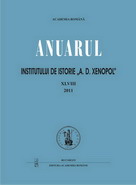The Emergence of the Medieval Towns in the Romanian Principalities. Romanian Historiography of the Twentieth Century
THE EMERGENCE OF THE MEDIEVAL TOWNS IN THE ROMANIAN PRINCIPALITIES. ROMANIAN HISTORIOGRAPHY OF THE TWENTIETH CENTURY
Author(s): Laurenţiu RădvanSubject(s): History, Middle Ages, Modern Age
Published by: Editura Academiei Române
Keywords: historiography;urbanization;ideology;medieval towns;Romania;
Summary/Abstract: This study shows how and why the interpretations of various historians from Romania were influenced by the times in which they lived and the ideologies they lived under. Before World War II, the Romanian historiography had a solid connection to the European one. In that period, the view that gave great credit to Germans in the urbanization process gained ground, thanks to major scholars such as Nicolae Iorga or Gheorghe I. Brătianu. However, a trend that supported a “local path” in the development of towns had also begun to gain popularity, with Constantin C. Giurescu as its advocate. This interpretation may be explained by taking into account the decades that followed the year 1918, after Greater Romania emerged and the country sought to establish an identity within the new European background. The Communists’ rise to power also led to a single ideology being enforced, which determined dramatic changes in historiography. The historians had limited freedom of movement, and historical creations had to be regulated by the authorities. The “autochtonist” current suited the regulators of historiography, especially since the regime was seeking for a way of its own to evolve in the Eastern bloc, but this time from a different perspective.
Journal: Anuarul Institutului de Istorie »A.D. Xenopol« - Iaşi
- Issue Year: LI/2014
- Issue No: 51
- Page Range: 45-58
- Page Count: 14
- Language: English

